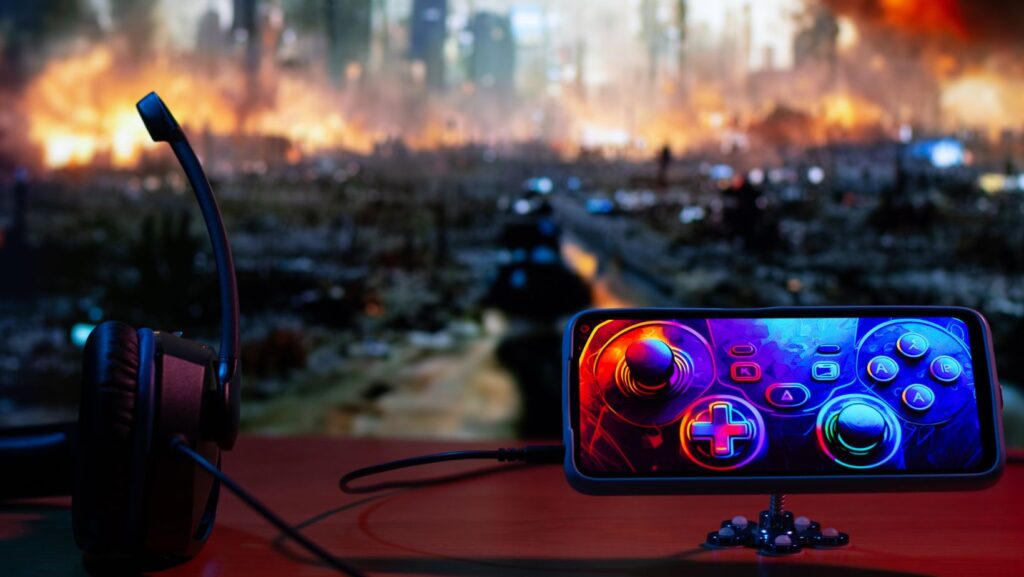
Immerse yourself in the captivating world of Harmonicode Sports, where rhythm meets physical prowess in a unique blend of competition and artistry. It’s an arena where athletes don’t just compete, they perform, transforming sports into a symphony of movement and sound.
Understanding Harmonicode Sports
Diving into the depths of this rhythmic revolution, Harmonicode Sports artfully merges rhythm and physical prowess. This unique fusion of distinct elements demands mental acuity, physical vibrancy, and a keen sense of rhythm. Harmonicode Sports propel athletes into an engrossing symphony of motion and sound.

Differing greatly from traditional sports, Harmonicode serves as a testament to the limitless innovation and creativity in sports. Its birth came from a need for something novel and exhilarating. And unlike the thrill and nostalgia surrounding retro gaming, or the competitive intensity of esports, Harmonicode Sports invites participants into a melody-ridden world where athleticism dances to the beat of harmony.

Familiar sports undergo rhythmical reinterpretation in this captivating modality of sportsmanship. Soccer, for instance, no longer relies purely on coordination, dribbling, and shooting. Instead, Harmonicode demands athletes to toe-tap, slide, and shimmy in synchronization with the pulsating rhythms, turning every play into a coordinated dance step amidst the torrid tempo of the game.

Basketball, too, leaps into exhilarating cadences in the realm of Harmonicode Sports. It replaces speed and strength with rhythm and synchronicity. Executing precise passes, setting up plays, and making blissful baskets all while keeping in step with the rhythmical commands.
Harmonicode goes beyond the surface of regular sports. Its ripple effect permeates into audience experience, transforming every spectator into a participant. As a spectator, one finds themselves entranced not just by the craft of the sportsmen but by the rhythm exuded, turning every game into a captivating melody of maneuvers.

Growing popularity of this innovative sport form hints at a bright future teeming with potential. Harmonicode resonates with the modern zeitgeist in the conceptual meeting of physicality and rhythm, prompting a fresh wave of interest amongst sports enthusiasts worldwide.
In essence, Harmonicode Sports is a testament to the evolving landscape of sports. It combines the experiential richness of physical sports, the melodic lure of music, and the tactile familiarity of rhythm, evolving into an intriguing new pillar of contemporary athleticism. As it continues to thrive, one can anticipate a future where sports and melody aren’t just practiced together, but actually exist as one harmonious entity.
Harmonicode Sports: Overview of the Game

Harmonicode Sports, a phenomenal blend of rhythm and athleticism, stands as a testament to the evolution of sports. Exemplifying this evolution, these sports incorporate a variety of athletic moves synchronized with musical beats. Often compared to retro gaming, the essence of Harmonicode Sports lies in their innovative approach to rhythm and athleticism.
The unique gaming structure, a critical component of Harmonicode Sports, functions on the basis of rhythm. Musical beats become the driving force behind the players’ movements, thus emphasizing mental agility. Players, armed with physical vibrancy, pace their game in synchrony with the underlying pulsations.

While similarities with esports may become evident in its competitive nature and participant interaction, Harmonicode Sports offer a distinctive experience. Participants do not just play; they perform, enthralling audiences with a symphony of motion and sound.
Soccer and basketball, reimagined through Harmonicode Sports, present a fresh perspective on conventional gaming. Athletes are challenged, not just physically, but also mentally, as rhythm permeates every aspect of the sport. In essence, playgrounds transform into captivating stages of rhythmic phenomena.

Beyond the spectacle, Harmonicode Sports also foster ‘active spectatorship,’ inviting audiences to partake in the rhythmic journey. This symbiosis between athletes and spectators underscores the charm of these sports, providing a riveting, immersive experience.
As Harmonicode Sports surge in popularity, their future holds promise. This unique fusion of physicality and rhythm, though relatively new, resonating widely among sporting enthusiasts, continually shapes the landscape of contemporary athleticism. Indeed, Harmonicode Sports are carving a niche in the realm of sports entertainment, intertwining the energy of sports with the magic of melody, and crafting a distinctive blend of rhythm and athleticism.
The Popularity of Harmonicode Sports

Harmonicode Sports garners immense popularity, tracing its roots from the dynamic interactive experiences combining rhythm and athleticism. The adoration stems from the innovative synthesis of physical prowess and melodic synchronization that redefined sports engagement. In fact, its meteoric ascent stems from various factors that encapsulate novelty, challenge, and accessibility.
Primarily, the allure of Harmonicode Sports lies in its novelty. Harmonicode Sports distance themselves from traditional sports, paving the way for a unique athletic experience that intertwines rhythm and athleticism. Echoes of retro gaming resonate in this innovative blend where skill and timing play crucial roles, reminiscent of arcade games that dominated the entertainment scene in the 80s and 90s.

Furthermore, the challenging nature of Harmonicode Sports amplifies its popularity. It demands honed skills of timing, adept physical maneuverability, and a keen sense of rhythm. The intriguing fusion of rhythm and refined athletic skills presents a challenge that resonates with competitive instincts, attracting individuals who crave dynamic and unique sporting challenges.
However, relating Harmonicode Sports’ popularity solely to physicality and rhythm overlooks the bigger phenomenon. The allure extends beyond the physical realm into the captivating notion of sports as an immersive rhythmic journey.

Accessibility also plays a significant role in its popularity. Harmonicode Sports surmounts geographic and physical limitations, making it more inclusive and paving the way for a broader audience base. Particularly, the paradigm shift towards esports mirrors this inclusivity. Esports’ swelling popularity demonstrates the growing acceptance of digitized websites as legitimate sporting arenas, reinforcing Harmonicode Sports’ appeal.
This engaging spectacle, a symphony of motion and sound, not only entertains but also forges intimate connections between sport, rhythm, and participants that transcends the conventional sporting experience.

Through novelty, challenge, and accessibility, Harmonicode Sports has swiftly climbed the ladder of public favor. It’s a testament to the shifting landscape of sports entertainment, valuing rhythm as a pivotal element and encouraging unique sporting endeavors that merge physicality and melodious rhythm. This burgeons the evolution of sports and their relationship with audiences.
Though the impact of Harmonicode Sports continues to be felt globally, it’s merely the start of their journey. The future of sports entertainment might increasingly behold the harmony of beats and athleticism, rhythmizing the sports industry and potentially revolutionizing the entire spectrum of active entertainment.
The Impact of Harmonicode Sports

Harmonicode Sports revolutionize fitness, bridging the gap between athleticism and rhythm. These sports provide multifaceted benefits, reshaping athletes’ perception of fitness. Through a unique blend of mental acuity, physical prowess, and rhythmic precision, they encourage comprehensive development, promoting healthier lifestyles. These impact areas typify Harmonicode Sports’ transformative effect on fitness:

- Development of Physical Strength and Endurance:
Typically, athletes experience substantial improvements in strength and endurance. Regular participation in these activities, with their intricate confluence of movement and rhythm, demands high energy expenditure. Consequently, they increase physical health markers, such as muscle strength and cardiovascular endurance. - Enhancement of Coordination and Balance:
Secondly, Harmonicode Sports fortify two often overlooked fitness pillars—coordination and balance. Each sport demands meticulous synchronization to musical beats, enhancing reflexes and precision. Thus, participants improve their neuro-motor capabilities, fostering a heightened sense of rhythm and timing. - Boost to Mental Health:
Aside from benefits for physical fitness, mental health gains significant boosts as well. These sports fuse competitiveness with rhythmic immersion, fostering an environment conducive to stress relief. Additionally, their fun, engaging nature can have positive effects on emotional well-being.

- Socialization through Active Participation:
Lastly, Harmonicode Sports offer a social website through a shared love for rhythm and sports. Its accessible format, reminiscent of retro gaming, incorporates esport elements, fostering social interaction. The collective rhythmic experience augments a sense of community and encourages active participation, nurturing a healthy lifestyle.
In sum, Harmonicode Sports showcase the potential of rhythm-infused sports, offering a refreshing perspective on fitness. More than just an evolution in sports entertainment, it underscores the seamless integration of rhythm and athleticism, forever altering the conventional approach to fitness as we know it.
Mastering Harmonicode Sports

Mastering Harmonicode Sports involves precision, agility, and rhythm. Drawing parallels from retro gaming and esports, this new wave of athletic activity emphasizes strategic decision-making, quick reflexes, and, most significantly, musical synchronicity.
Success in Harmonicode Sports hinges on rhythmic precision. Athletes synchronize their actions to the beat of the music, similar to the precise timing required in popular dance-based esports games. For instance, Harmonicode basketball players release their shot as the beat drops, not only enhancing the game’s aesthetics but also improving their precision.

Harmonicode Sports cultivate both physical and mental strength. Athletes perform demanding movements that foster strength and endurance, just like traditional sports. Meanwhile, the rhythmic component enhances cognitive abilities, promoting sharper focus and better decision-making. Harvard Medical School backs this claim, noting that music stimulates regions of the brain responsible for movement, attention, planning, and memory.
Foster Teamwork and Community Spirit

The inclusive nature of Harmonicode Sports encourages active participation and teamwork. Athletes engage in coordinated movements, fostering a sense of unity similar to the camaraderie experienced in multiplayer esports competitions. Supported by the Social Science Research Journal, group rhythm activities enhance social bonds, communication skills, and a sense of togetherness.
Using Proper Equipment
Using the right equipment becomes crucial when mastering Harmonicode Sports. Not unlike selecting the ideal joystick for retro gaming, employers must choose instruments based on their specific needs and preferences. For instance, a drumstick must suit the player’s hand and the rhythm of the game.

Taking these aspects into account, athletes can enhance their Harmonicode Sports skills, finding joy in the unique blend of rhythm, athleticism, and strategic gameplay. Indeed, Harmonicode Sports reinvent traditional sports, transforming them into captivating, inclusive, and healthful activities.
The Future of Harmonicode Sports
Harmonicode sports demonstrate parallels with growth trends in other sectors, particularly retro gaming and esports. Music, rhythm, agility, precision – these elements echo within Harmonicode sports, creating more than games but, indeed, a distinct form of leisure. In the future, novelties might enter the scene, pushing the boundaries of this revolutionary athletic experience.

Its resemblance with retro gaming and esports hints at more embrace in the digital world. Just as retro games found resurgence amidst modern technologies, Harmonicode sports seem poised for a digital revolution. Esports leaders stand as examples, displaying how once traditional concepts can transition into thriving digital realities.
Increased integration between Harmonicode sports and technology turns probable in the future. With advancements like AI and virtual reality, participants could delve into virtual Harmonicode sports sessions from the comfort of their homes, widening accessibility. Additionally, AI websites could assist in formulating athletes’ rhythm strategies, ensuring optimal performance.

Emergence of professional leagues and competitions can be anticipated. As participants become more skilled and passionate, the field may mature into a professional website. These competitions would attract spectators and athletes alike, fueling the growth and popularity of Harmonicode sports.
Inclusivity signifies another future trend of Harmonicode sports. These activities, by design, foster teamwork and camaraderie. As more people get involved, the move towards inclusive, community-enhancing sports emerges stronger.

The equipment market for Harmonicode sports is expected to expand. As athletes seek premium experiences, the demand for high-quality equipment increases, replicating the evolving nature of joystick technologies in gaming.
As the future unfolds, Harmonicode sports appear set to remain a significant player in the fitness domain, merging the spheres of gaming, music, community, and athletic prowess.
The Golden Age of Retro Gaming

Arguably, the late 1970s and into the 1980s ushered in the golden age of retro gaming. Industry giants such as Atari, Nintendo, and Sega took the center stage, introducing groundbreaking gaming consoles and games, today regarded as classics. Released in 1972, the likes of Pong, Atari’s first home version, represents a landmark example, opening gamers to an expansive world far from reality, captivating a universal audience.
Atari might have sparked this golden age, but several other players staked a claim in this era. Nintendo, a brand synonymous with retro gaming, released the Nintendo Entertainment System (NES) and the Game Boy in the 1980s. Games such as Super Mario Bros., The Legend of Zelda, and Donkey Kong came bursting onto the scene. The cultural phenomenon these names inspired remains unparalleled, with iconic characters such as Mario and Zelda standing the test of time.

Alongside Atari and Nintendo, Sega’s entry into the console market with the Sega Genesis added another layer of complexity to the retro gaming story. Noteworthy for packed-in games like Sonic the Hedgehog, the console gave birth to one of gaming’s most iconic figures. Moreover, Sega’s aggressive marketing campaigns triggered a console war against Nintendo that remains one of the most memorable moments in gaming history.

This golden age wasn’t simply about the consoles and games; it was about the impact. It’s this era that ignited a mammoth industry, creating a blueprint for future generations of game design. This gaming revolution wasn’t limited to living rooms and arcades; it reached into pop culture, movies, and music, effectively penetrating almost every corner of life.
Critical advancements such as 8-bit graphics, MIDI music, and website-style gameplay were introduced during this golden age. Their influence echoes throughout modern gaming, with robust narratives, immersive worlds, and cutting-edge graphics all tracing their genesis back to these pioneering times.

While the golden age of retro gaming might seem like history, its impact and influence reign supreme. Echoes of the classics molded this halcyon period reverberate still, shaping gaming’s contour to this day. It’s this deep-seated nostalgia and timeless value that makes this era pivotal in the vast tapestry of video gaming history.
Modern Video Gaming

Modern video gaming stands on the shoulders of the giants that revolutionized the industry in the late 20th century. As the narrative pivots from retro gaming, attention shifts to the immersive, high-definition universes of today’s video games. Drawing its influences from iconic predecessors, modern video gaming builds upon the foundation laid during the golden age of retro gaming, combining classical narratives with advanced technology to create immersive, engaging gaming experiences.

Gamers today engage with stunning graphic displays that dwarf their 8-bit forebears. In games like The Witcher 3 and Assassin’s Creed Valhalla, players are transported to meticulously crafted worlds, offering a level of realism that goes beyond the pixelated charm of retro games. Developers employ cutting-edge technology, incorporating weather systems, real-time shadow casting, and intricate character details into these enthralling landscapes.
Moreover, improvements in gameplay mechanics drastically altered the gaming experience. Game design emphasizes player choice and branches out narratives with multiple outcomes, a deviation from retro games’ linear pathways. For instance, Red Dead Redemption 2 offers a distinctive gaming experience based on player choices, where decisions influence the story’s progression.

Further, modern video gaming marked a shift towards an increasingly interconnected world. The rise of multiplayer online gaming, as seen in Fortnite and Call of Duty: Warzone, encourages social interaction among passionate gamers. This concept — a far cry from the solo gaming experience of yesteryears — provides opportunities for cooperation, competition, and community building, further enriching the overall gaming experience.
Lastly, in retrospect, the gaming industry has matured and broadened immensely, expanding from simple entertainment to art forms and professional careers. Games like The Last of Us Part II, renowned for its storytelling prowess, challenge the narrative standards set by films and literature. On the other hand, esports has breached mainstream consciousness with games like Dota 2 and League of Legends offering hefty cash prizes, turning gamers into recognized professional athletes.

All these advancements, traceable back to the industry’s humble beginnings, highlight the key developments in modern video gaming — an era where games are not limited by technological constraints but empowered by them, redefining what the genre could accomplish and setting new milestones in digital entertainment.
Connection between Retro and Video Gaming
Spanning varied generations, the gaming industry has experienced an intricate evolution. Originally, there lay a foundation of simple 8-bit titles like Space Invaders and Pac-Man, providing a launchpad for the inception of video gaming. It’s imperative to understand that modern video gaming isn’t an isolated entity but rather a successor of retro gaming.

Achievements from the retro gaming era, for instance, groundbreaking effects, user-friendly mechanics, and immersive storytelling in Final Fantasy games, yielded core components for video games. Modern games like Mass Effect and Dragon Age, consolidate these components, offering players character-centered stories, rife with profound choices. Moreover, the simplistic beauty of pixel art graphics, prevalent in retro games, gives rise to independent titles such as Hollow Knight or Shovel Knight, reflecting visual aesthetics of classic 8-bit titles.

Technological development sparked another key aspect: increased focus on multiplayer gaming. Numerous retro games, like Contra or Street Fighter, initiated a shift towards multiplayer experiences. Today, games such as World of Warcraft or PUBG carry forward this legacy, providing massive multiplayer online experiences to millions worldwide.
Furthermore, the esports industry, one of the fastest-growing sectors in digital entertainment, owes its inception to the competitive nature of retro gaming. Titles like Pong set a blueprint practical for online competition, laying groundwork for epic esports battles seen in games such as Overwatch or Dota 2.

Emulation in the modern era is another pivotal link between retro and video gaming. Through software like RetroPie or OpenEmu, players access and experience retro games on modern consoles, a testament to the lasting appeal of these classics. Similarly, ‘remakes’ and ‘reboots,’ such as Resident Evil 2 Remake and Crash Bandicoot N. Sane Trilogy, rejuvenate classic adventures with contemporary graphics and gameplay tweaks.

This intertwining of retro and video gaming illustrates a circular narrative, highlighting the gaming industry’s evolution over time and underlining the indelible mark left by classic games. The video games now celebrated for their technological advancement, creativity, and immersive experiences owe a considerable debt to their classic, retro ancestors.
The Thriving Community of Retro and Video Gaming

Retro and video gaming shares a bond that not only extends back in time but also anchors a vibrant and thriving community today. Datum shows that the retro gaming scene represents over a quarter of the global gaming community, and this figure escalates each year. For instance, Retro Games Fair, a UK-based event, witnessed record-breaking footfall in 2019, reflecting the rekindled interest in arcade-era marvels.
The community’s heart pulses online, with myriad websites bolstering this shared passion. Websites and forums like Atari Age and Retro Gamer bring together enthusiasts, hashing out everything from plwebsite atform specifics, game overviews, technical troubleshooting, to eager anticipation for the next re-release. Key exchanges happen on social media, as highlighted by Reddit’s r/retrogaming with over 300,000 subscribers chasing the ghosts of pixels past.

Steam, a cornerstone of PC gaming, reserves an illustrious section for retro and indie games. Here, players revisit gems from yesteryears or discover new titles that pay homage to the classics. This comprehensive archive is both a testament to retro gaming’s continued popularity and a gateway for today’s gamers to explore a nostalgic gaming landscape.
Equally, the community thrives offline. Esports events, such as EVO and DreamHack, embody the retro spirit with tournaments for classic games like Street Fighter and Super Smash Bros. Annual retro conventions, such as California’s PRGE and the UK’s Play Expo, provide websites for hands-on interaction, trading, and networking.

Furthermore, the retro gaming community remains united by a shared love for restoration. From restoration projects that breathe new life into rusty hardware to the creation of ‘mod’ games that integrate modern enhancements into retro titles, the community transcends gaming norms.
Testament to the thriving retro gaming community, an increased generation of content creators and streamers specialize in retro gaming, providing a wealth of entertainment and educational content for their peers and viewers.

In the realm of retro and video gaming, the community proves resilient, despite the rapid advancement of technology in contemporary gaming. Retro game enthusiasts continue to champion the games of yesteryears, allowing the classics to flourish in our memories and on modern websites. In essence, retro gaming’s past forms an indelible part of its present and lays down footprints leading to the future of gaming.

Retro gaming’s influence on the modern video gaming landscape is undeniable. It’s not just about nostalgia or reliving the golden age of arcades. It’s about the evolution of gaming itself, from the simplicity and competitiveness of the classics to the complex narratives and multiplayer experiences of today’s titles. The rise of emulation technology and the resurgence of remakes are testament to the timeless appeal of these games.

Moreover, the thriving community and the profitable business side of retro gaming underscore its enduring relevance. Whether it’s through events like Retro Games Fair, websites like Atari Age and Twitch, or the release of remakes by major companies, retro gaming continues to shape the industry. It’s more than a trend; it’s a testament to the power of gaming’s past shaping its future.
The Business side of Retro and Video Gaming
The influence of retro and video gaming extends far beyond community engagement and nostalgia, culminating in a profitable business niche. Such industry, marked by the selling of classic consoles, game cartridges, and associated merchandise, boasts remarkable fiscal fortitude despite its inherent vintage nature.

Marketplaces like eBay, Amazon, and specialized outlets like DKOldies and Lukie Games capitalize on the demand for retro gaming hardware and software. For instance, an unopened 1985 Super Mario Bros. game for the Nintendo Entertainment System (NES) fetched over $660,000 at an auction conducted by Heritage Auctions in April 2021. Meanwhile, a sealed copy of The Legend of Zelda for NES sold for a record-breaking $870,000 in July of 2021 at the same auction house. Such instances affirm the significant monetary value attached to retro gaming items and the willingness of collectors to secure these treasured artifacts.
Gamers Community

Harmonicode Sports it’s a revolution that’s set to redefine the landscape of athletics and gaming. By bridging the gap between physical prowess and rhythmic precision, it’s creating a unique niche in the fitness realm. With a future brimming with digital integration and professional leagues, Harmonicode Sports is poised to become a significant player in the industry.
Its inclusivity and expanding equipment market are additional feathers in its cap, promising a sport that’s accessible and engaging for all. As it continues to evolve, Harmonicode Sports will undoubtedly keep blending gaming, music, community, and athleticism in exciting new ways. Keep an eye on this dynamic fusion; it’s a game-changer.


